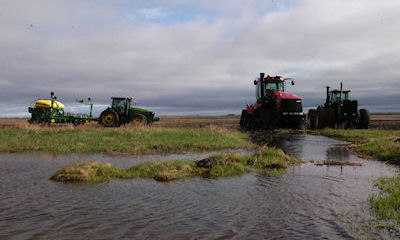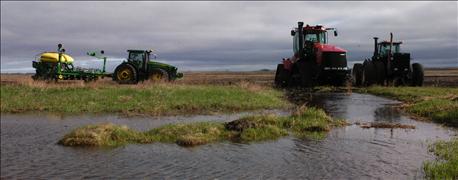September 30, 2016

Some Iowa corn and soybean producers are facing substantial if not complete crop losses due to excessive rain and flooding this fall. Fortunately, nearly 90% of Iowa’s corn and soybean acres are protected by Multiple Peril Crop Insurance (MPCI).
Dr. William Edwards, a retired ISU Extension farm management economist and member of Wallaces Farmer magazine’s Timely Tips panel, provides the following information and advice on issues regarding the 2016 growing season’s flooding. He explains how flooding affects crop insurance, rented acres and other things farmers need to think about as they look ahead to 2017.
Crop insurance considerations for Iowa’s flooded fields

FLOODED FIELDS: How much will it cost to clean up fields and bring them back into production next year? Most Iowa farmers haven’t had experience with fields being underwater for extended periods of time, so effects are difficult to estimate. Problems will range from removing debris to leveling eroded areas to restoring fertility.
Most Iowa farmers purchase crop insurance policies with a 75% to 85% level of coverage. This means that if crops are a total loss, the farmer must withstand the first 15% to 25% of the loss. However, in 2016 nearly 90% of the crop acres insured in Iowa are covered under Revenue Protection policies, which offer an increasing guarantee if prices increase between February and October.
So far, this has added about 80 cents per bushel to soybean guarantees, while the current corn futures price is actually below the February average. Moreover, since Revenue Protection (RP) policies are settled at the average nearby futures price during the month of October, rather than local cash prices, farmers receive a bonus equal to the fall grain basis in their area.
Producers with crops that have been totally destroyed by flooding will not have to incur the variable costs of harvesting. This could save around $20 per acre for soybeans and perhaps $50 per acre for corn, depending on potential yields and drying costs. Nevertheless, even producers who carried insurance at a high coverage level could be looking at net revenues near or below those obtained from normal yields this year.
Potential losses, how to calculate crop insurance returns
For example, assume an insured tract has an expected corn yield and insurance proven yield of 175 bushels per acre. A normal crop marketed at $3.00 per bushel would bring $525 per acre. The insurance indemnity payment for an 80% RP guarantee, zero yield, and a February futures price of $3.86 would equal 175 bushels x $3.86 x 80% = $540. Saving $50 in harvest costs would give an equivalent of $590 per acre, or $65 above the value of a normal crop.
For soybeans, assume both the expected yield and the proven yield are 60 bushels per acre, and the crop could be marketed at $9.00 per bushel. Gross income for a normal crop would be $540 per acre. The insurance payment for a complete crop failure and a $9.65 October futures price would be 60 bushels x $9.65 x 80% = $463. Savings of $20 in harvesting costs brings the equivalent of $483 per acre, or $57 below the value of a normal crop.
Non-flooded acres also figure into production calculations
In many cases, of course, flooded acres will make up only a portion of the insured unit, so production from non-flooded acres will be averaged in with the zero yields from the flooded acres.
The real question is how much will it cost to clean up fields and bring them back into production next year? Most Iowa farmers have not had experience with fields being under water for extended periods of time, so effects are difficult to estimate. Problems will range from physically removing debris to leveling eroded areas to restoring fertility.
Land rental contracts, how will flood damage affect 2017 rent?
What do these flood damage and crop insurance questions imply for land rental contracts? A great deal of uncertainty, for one thing. Farmland lease agreements in Iowa continue in effect for another year under the same terms—if they were not terminated on or before September 1, 2016.
Landowners will have to bear the burden of mitigating flood damages – that goes with owning property. But, a better solution may be for renters and owners to work together to repair the damage and bring the land back into production. Farm operators may have access to machinery that can help accomplish the job that owners do not. In return, tenants should be compensated for their efforts, either directly, through a significant discount on the 2017 rent, or with a long-term lease.
What about next year? Will this flooded land be planted in 2017?
In some cases there may be doubt as to whether land flooded this year can even be planted next year. USDA’s Risk Management Agency rules state that land must be physically available for planting to be insurable. Land that cannot be planted due to weather events that occurred before the crop insurance sales closing date (March 15 in Iowa) is not eligible for prevented planting payments. When operators report their 2016 production, they can request that their 2016 yield histories reflect a value equal to 60% of the county “T-yield” rather than a zero or very low yield.
Close communication and cooperation between owners, crop insurance agents and renters can be a “win-win” strategy in the long run, but recovery from this year’s flooding may take several years.
Resources to help you deal with flooding, related issues
Additional information about managing flood damaged cropland will be available from Iowa State University Extension and Outreach as the waters recede and the situation is assessed. Keep in mind, dealing with issues from flooding can be stressful. Reach out to resources such as Iowa Concern Hotline, with trained staff available to listen.
You May Also Like




